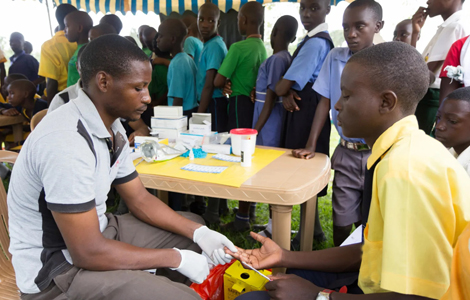
HIV/AIDS
In the past decade, the world has made significant progress in the fight against HIV due to large-scale treatment programs and efforts to prevent infection among infants born to mothers with HIV. The global incidence of HIV has declined by nearly 40 percent since 2001, and 17 million people worldwide are receiving anti retro-viral treatment. Countries and global partners can continue to accelerate progress by sustaining their investments to improve the efficiency and effectiveness of HIV prevention, treatment programs and support research into new and better prevention methods.
The goal of our program is to accelerate the decline in HIV infection worldwide and save lives by ensuring expanded and simplified HIV treatment and improved and effective use of interventions to prevent new infections. In each of our areas of focus, we work with an array of partners, including government agencies in high-burden and donor countries, multilateral organizations,
nongovernmental organizations, academic institutions, community organizations, and private industry.
We also work to ensure that adequate funding and appropriate global and national-level policies are in place to support HIV prevention and treatment efforts, research and development, and efforts to understand the motivations and needs of high-risk populations. About half of all people living with HIV, particularly men, do not know they have the virus. We solicit for funding to support development and appropriate use of novel tools that can greatly increase the number of people who know their status and who seek treatment.
Malaria Prevention
Malaria occurs in nearly 100 countries worldwide, exacting a huge toll on human health and imposing a heavy social and economic burden in developing countries, particularly in Sub-Saharan Africa and South Asia. An estimated 207 million people suffered from the disease in 2012, and about 627,000 died. About 90 percent of the deaths were in Sub-Saharan Africa, and 77 percent were among children under age 5.
Malaria is caused by parasites transmitted by mosquitoes. Even in relatively mild cases, it can cause high fever, chills, flu-like symptoms, and severe anemia. These symptoms can be especially dangerous for pregnant women and young children who are experiencing the disease for the first time. Severe malaria can cause lifelong intellectual disabilities in children, and malaria’s economic impact is estimated to cost billions of dollars in lost productivity every year.
In the past dozen years, malaria funding has increased nearly 10-fold and major gains have been made in controlling the disease in developing nations. The number of new cases has declined by 25 percent globally, and deaths from malaria have fallen by 42 percent. These gains have been made through a combination of interventions, including timely diagnosis and treatment using reliable diagnostic tests and effective drugs; indoor spraying with safe, long-lasting insecticides; and the use of bed nets treated with long-lasting insecticide to protect people from mosquito bites at night.
Current tools and treatments are insufficient, however, to achieve elimination in many countries. And the cost of maintaining these interventions has reached several billion dollars a year. The malaria parasite has begun to develop resistance to currently available insecticides and drugs, and these resistant strains will spread. Infected individuals who are asymptomatic—the majority of those infected—remain an ongoing source of transmission.
Given sufficient global commitment, major investments in research and development, and transformative new tools and delivery strategies, the ambitious goal of malaria eradication can be met. Without an immediate, coordinated worldwide effort to eradicate malaria, this window of opportunity could close indefinitely and the progress already achieved will remain at risk.
Malaria is preventable and treatable, history shows that it can be eliminated. Less than a century ago, it was prevalent across the world, including Europe and North America. Malaria was eliminated in most of Western Europe by the mid-1930s; the United States achieved elimination of the disease in 1951.
The world have the opportunity to accelerate progress toward elimination in all countries by improving the delivery of existing interventions as well as developing new tools and new strategies that target not just malaria-transmitting mosquitoes but also the parasite itself, which can survive in humans for more than 10 years. By mobilizing the required commitment and resources, we can achieve global eradication and save many millions of lives.
Malaria was one of the top priority of the Alliance Creative Community Project to create awareness on and addresses the areas of which we believe the foundation is best positioned, among a broad spectrum of partners, to develop groundbreaking approaches to reducing the burden of malaria and accelerating progress toward eradication of the disease.
Our Malaria strategy is based on a core set of foundational principles that support our evolving strategic choices.
Malaria eradication is defined as removing the parasites that cause human malaria from the human population. Simply interrupting transmission is not sufficient to achieve eradication.
Eradication can be accelerated by new drug regimens and strategies that lead to complete parasitologic cure of the individual. Current artemisinin-based regimens achieve only clinical cure of the individual and do not eliminate the forms of the parasites that are responsible for continued transmission.
The majority of malaria infections occur in asymptomatic people, who are a source of continued transmission. A successful and accelerated eradication effort will target asymptomatic infections through community-based efforts.
Emerging resistance to current drugs and insecticides is an immediate threat to recent gains and an obstacle to future progress. Use of current tools and development of new tools should be guided by this evolutionary imperative.
Malaria is biologically and ecologically different throughout the world. Malaria eradication will depend on strategies developed and implemented on a local or regional level.
We concentrate our resources in areas where we can identify significant leverage points, and we assume risks that are more challenging for others to take.
